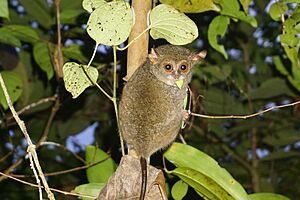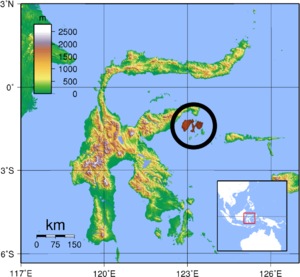Peleng tarsier facts for kids
Quick facts for kids Peleng tarsier |
|
|---|---|
 |
|
| Conservation status | |
| Scientific classification | |
| Genus: |
Tarsius
|
| Species: |
pelengensis
|
 |
|
| Range of the Peleng tarsier | |
The Peleng tarsier (Tarsius pelengensis) is a small, furry animal. It is a type of primate, like monkeys or apes. This tarsier lives on the island of Peleng in Indonesia. Peleng Island is just east of Sulawesi.
Peleng tarsiers are nocturnal, which means they are active mostly at night. People on Peleng Island have different names for this animal. In the western part of the island, they call it Lakasinding. In the eastern part, they call it Siling.
Contents
What Does a Peleng Tarsier Look Like?
Tarsiers are small and very agile primates. They are good at climbing and jumping. They have long fingers and toes that help them grip branches. These fingers and toes also have special gripping pads.
Peleng tarsiers have very large eyes, which help them see in the dark. They also have big ears. Their fur is usually greyish. An adult tarsier's body is about 12.5 cm (5 in) long. Its tail is twice as long as its body!
Most adult Peleng tarsiers weigh between 100 and 140 g (3.5 and 4.9 oz). Male tarsiers are usually a little bit bigger than females.
Where Do Peleng Tarsiers Live?
The Peleng tarsier is an endemic animal. This means it is found only in one specific place. For the Peleng tarsier, that place is Peleng Island. This island is located off the east coast of Sulawesi. It might also live on other smaller islands nearby, which are part of the Banggai Archipelago.
Peleng Tarsier Habitat
These tarsiers naturally live in primary forest. This is an old forest that has not been disturbed much by humans. However, people have cut down many trees on Peleng Island. This is called illegal logging and forest clearance. Because of this, only about 9% of the original primary forest is left.
Scientists do not know much about what kind of habitat the Peleng tarsier needs. But other types of tarsiers can live in secondary forest. This is a forest that has grown back after being cut down. It seems likely that the Peleng tarsier can also live in secondary forests. About 63% of Peleng Island is covered in secondary forest. This means that a large part of the island, about 72%, could be good habitat for these tarsiers.
How Do Peleng Tarsiers Live?
Tarsiers are social animals. They usually live in family groups. Each family group has its own home area.
What Do Peleng Tarsiers Eat?
Peleng tarsiers are carnivorous. This means they eat meat. Their diet includes insects, spiders, and other small bugs. They also eat small vertebrates, which are animals with backbones.
Daily Life and Communication
During the day, Peleng tarsiers sleep in hidden spots. They like to hide in tangled plants a few meters off the ground. When the sun sets, they wake up. They spend the night looking for food.
Like other tarsiers, the Peleng tarsier can turn its head almost 180 degrees in each direction. This is similar to how an owl can turn its head. This helps them see all around without moving their bodies.
Breeding pairs of Peleng tarsiers talk to each other. They make special calls that sound like a duet. These calls are very similar to the calls of Dian's tarsier (Tarsius dentatus). Because their calls are so alike, scientists think these two species are closely related.
Scientists study the calls of tarsiers on Sulawesi and nearby islands. This helps them tell different species apart. It also shows that there might be four more types of tarsiers that scientists have not yet officially named.


